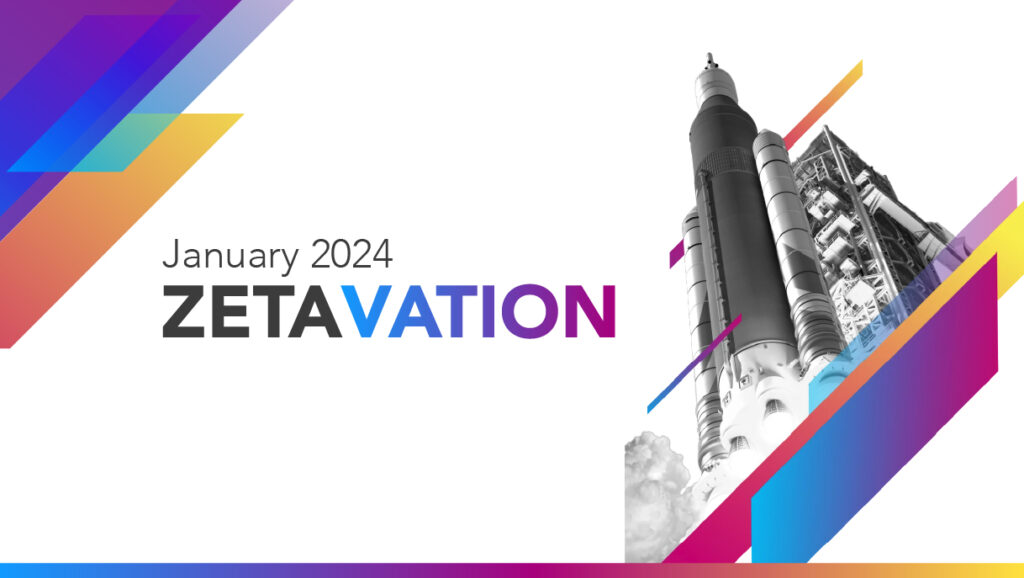
Articles | April 22, 2020 | 3 min read
3 Email Campaigns Every Marketer Should Be Running
Believe it or not, email is the best digital marketing channel for ROI, and 72 percent of consumers consider email their favorite channel for receiving marketing messages.
This reality means delivering dynamic, personalized messaging to the inboxes of subscribers has never been more important. To help you better use email to captivate and persuade everyone from top-funnel prospects to existing customers, Zeta wants you to know about three kinds of email campaigns you need to deploy ASAP.
As the old saying goes, you only get one chance to make a first impression. To that end, you need to make sure that everyone who signs up for your brand’s mailing list is immediately seeded into a thoughtful, compelling Welcome Campaign.
A multi-touch email series focused on welcoming people to your brand (as well as your brand’s products, services, and values) is critical to forming a strong, long-term relationship. Put another way, think of your Welcome Campaign as the foundation upon which the rest of the consumer relationship will be built—the sturdier the foundation, the sturdier the rest of the relationship will be.
Use your Welcome Campaign as a platform for cultivating trust with people who are new to your brand. Also, use your Welcome Campaign as an opportunity to incentivize rapid adoption of your company’s products, services, or social channels by pitching discounts, promotions, or other special offerings.
Open rates are 43% higher for welcome emails than other marketing emails.
Click rates are 11% higher for welcome emails than other marketing emails.
Welcome emails increase followup email engagement by more than 40%.
Welcome emails successfully reach 84% of email inboxes.
Welcome emails have a 23% read rate.
Personalization: Increases median ROI by 122%.
Social Links: Email recipients are 3X more likely to share content on social.
Promotion: 72% of consumers are OK receiving promotional content in a welcome email.
Every brand should send regular, personalized emails to its prospects and current customers, but these emails shouldn’t come out of the blue—they should be tied to the real-time actions of recipients.
Put another way, the content behind your Real-Time Campaign should be determined—not by you or your marketing team—but by your recipient’s known preferences and behavior. That way your brand can ensure it’s not only delivering the right message and the right visuals, but delivering them at exactly the right time.
A classic example of a Real-Time Campaign email is the cart-abandonment email—a personalized message sent to a known-customer who “abandons” their digital shopping cart before completing the purchase. The real-time email is triggered by an action (cart abandonment) and serves as a personalized form of outreach designed to entice the recipient to come back and complete their purchase.
81% of consumers who receive real-time emails triggered by online shopping behavior are at least somewhat likely to make another purchase.
Real-Time Campaigns are 133% more likely to correspond with the recipient’s purchase cycle.
Real-time, triggered emails generate 75% of all email marketing revenue.
Relevance: The #1 reason people unsubscribe from an email list is irrelevance.
Timing: Proper timing can improve open rates by more than 200%.
CTA: Increases the likelihood of a conversion by nearly 30%.
One of the most frequently cited marketing statistics is that acquiring a new customer is 5X to 25X more expensive than retaining an existing one—and that’s why the Re-Engagement Campaign exists.
The Re-Engagement Campaign is all about countering churn by finding a way to reignite the relationship with customers who’ve gone cold, using a variety of tactics from enticing offers to customer feedback requests. Done properly, your Re-Engagement Campaign will convince old customers that your brand is still worth doing business with.
Re-engagement emails improve customer satisfaction, and satisfied customers are 154% more likely to remain subscribers.
Most brands will lose about 23% of their email subscribers every year without re-engagement.
45% of recipients who receive re-engagement emails will ultimately re-engage.
Persistence: Multiple attempts at re-engagement are 2.4X more likely to drive a positive response than a single attempt.
Interaction: Things like polls and surveys are twice as likely to boost customer engagement overall.
Money: Re-engagement messaging that speaks to the wallet is 2X more likely to be read.
No company’s email marketing strategy will ever be perfect end-to-end, but so long as brands are deploying all three of the aforementioned campaigns, they stand a good chance of being more successful with email marketing than their competitors.
And being “better” at email marketing matters—91% of US consumers check their email every single day, which is why it remains significantly more effective at customer acquisition and retention than many other channels, including social media.
In terms of connecting with consumers across the customer journey, nothing offers the flexibility, the freedom, or the ROI of email…As long as you and your brand go about email the right way, you will win.
This reality means delivering dynamic, personalized messaging to the inboxes of subscribers has never been more important. To help you better use email to captivate and persuade everyone from top-funnel prospects to existing customers, Zeta wants you to know about three kinds of email campaigns you need to deploy ASAP.
Campaign #1 — The Welcome Campaign
As the old saying goes, you only get one chance to make a first impression. To that end, you need to make sure that everyone who signs up for your brand’s mailing list is immediately seeded into a thoughtful, compelling Welcome Campaign.
A multi-touch email series focused on welcoming people to your brand (as well as your brand’s products, services, and values) is critical to forming a strong, long-term relationship. Put another way, think of your Welcome Campaign as the foundation upon which the rest of the consumer relationship will be built—the sturdier the foundation, the sturdier the rest of the relationship will be.
Use your Welcome Campaign as a platform for cultivating trust with people who are new to your brand. Also, use your Welcome Campaign as an opportunity to incentivize rapid adoption of your company’s products, services, or social channels by pitching discounts, promotions, or other special offerings.
How important are welcome emails?
Open rates are 43% higher for welcome emails than other marketing emails.
Click rates are 11% higher for welcome emails than other marketing emails.
Welcome emails increase followup email engagement by more than 40%.
Welcome emails successfully reach 84% of email inboxes.
Welcome emails have a 23% read rate.
What makes a great welcome email?
Personalization: Increases median ROI by 122%.
Social Links: Email recipients are 3X more likely to share content on social.
Promotion: 72% of consumers are OK receiving promotional content in a welcome email.
Campaign #2 — The Real-Time Campaign
Every brand should send regular, personalized emails to its prospects and current customers, but these emails shouldn’t come out of the blue—they should be tied to the real-time actions of recipients.
Put another way, the content behind your Real-Time Campaign should be determined—not by you or your marketing team—but by your recipient’s known preferences and behavior. That way your brand can ensure it’s not only delivering the right message and the right visuals, but delivering them at exactly the right time.
A classic example of a Real-Time Campaign email is the cart-abandonment email—a personalized message sent to a known-customer who “abandons” their digital shopping cart before completing the purchase. The real-time email is triggered by an action (cart abandonment) and serves as a personalized form of outreach designed to entice the recipient to come back and complete their purchase.
How important are real-time emails?
81% of consumers who receive real-time emails triggered by online shopping behavior are at least somewhat likely to make another purchase.
Real-Time Campaigns are 133% more likely to correspond with the recipient’s purchase cycle.
Real-time, triggered emails generate 75% of all email marketing revenue.
What makes a great real-time email?
Relevance: The #1 reason people unsubscribe from an email list is irrelevance.
Timing: Proper timing can improve open rates by more than 200%.
CTA: Increases the likelihood of a conversion by nearly 30%.
Campaign #3 — The Re-Engagement Campaign
One of the most frequently cited marketing statistics is that acquiring a new customer is 5X to 25X more expensive than retaining an existing one—and that’s why the Re-Engagement Campaign exists.
The Re-Engagement Campaign is all about countering churn by finding a way to reignite the relationship with customers who’ve gone cold, using a variety of tactics from enticing offers to customer feedback requests. Done properly, your Re-Engagement Campaign will convince old customers that your brand is still worth doing business with.
How important are re-engagement emails?
Re-engagement emails improve customer satisfaction, and satisfied customers are 154% more likely to remain subscribers.
Most brands will lose about 23% of their email subscribers every year without re-engagement.
45% of recipients who receive re-engagement emails will ultimately re-engage.
What makes a great re-engagement email?
Persistence: Multiple attempts at re-engagement are 2.4X more likely to drive a positive response than a single attempt.
Interaction: Things like polls and surveys are twice as likely to boost customer engagement overall.
Money: Re-engagement messaging that speaks to the wallet is 2X more likely to be read.
The bottom line
No company’s email marketing strategy will ever be perfect end-to-end, but so long as brands are deploying all three of the aforementioned campaigns, they stand a good chance of being more successful with email marketing than their competitors.
And being “better” at email marketing matters—91% of US consumers check their email every single day, which is why it remains significantly more effective at customer acquisition and retention than many other channels, including social media.
In terms of connecting with consumers across the customer journey, nothing offers the flexibility, the freedom, or the ROI of email…As long as you and your brand go about email the right way, you will win.


